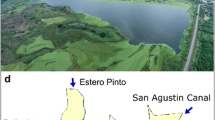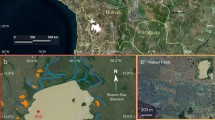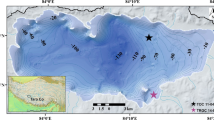Abstract
We examined intra-basin spatial variability of sedimentary geochemical and isotopic signals using a network of five sediment cores from a small lake in southern Costa Rica with a history of prehistoric maize agriculture in its watershed. All cores show a similar pattern of agricultural activity (2000–1000 cal yr BP), a transitional period of forest recovery (1000–675 cal yr BP), and a period after forest reestablishment (675–400 cal yr BP). During the agricultural period, bulk sediment stable carbon isotope ratios (δ13CTOC) indicate significant forest clearance, percent total organic carbon (%TOC) is low due to accelerated erosion and dilution from mineral inputs to the lake, and carbon/nitrogen (C/N) ratios are consistent with increased productivity. At the conclusion of the agricultural period, δ13CTOC and %TOC indicate rapid forest recovery and reduced mineral inputs and C/N ratios suggest lower lake productivity. There is little between-core variation in the magnitude of the agricultural signal for the four cores taken near the shore, but these cores indicate different timing for the end of widespread agriculture in the watershed. Three of these four cores indicate nearly all agriculture ended by 1000 cal yr BP, but in the fourth core agricultural indicators persist until 675 cal yr BP. The core from the center of the lake shows a gradual decline in proxies indicating agriculture from 950 to 650 cal yr BP, which suggests sediment-reworking processes are integrating material from the entire basin as it is transported to the deeper portions of the lake. Differences between the records from the cores recovered near the shore illustrate the potential of multiple core studies to create spatially explicit paleoenvironmental reconstructions, while the delayed and less abrupt changes in the core from the center of the lake highlight the importance of sediment reworking of paleoenvironmental indicators.






Similar content being viewed by others

References
Anchukaitis K, Horn SP (2005) A 2000-year reconstruction of forest disturbance from southern Pacific Costa Rica. Palaeogeogr Palaeoclimatol Palaeoecol 221:35–54
Anderson NJ (1989) A whole-basin diatom accumulation rate for a small eutrophic lake in northern Ireland and its palaeoecological implications. J Ecol 77:926–1846
Anderson NJ (1990a) Spatial pattern of recent sediment and diatom accumulation in a small, monomictic, eutrophic lake. J Paleolimnol 3:143–160
Anderson NJ (1990b) Variability of diatom concentrations and accumulation rates in sediments of a small lake basin. Limnol Oceanogr 35:497–508
Anderson NJ (1998) Variability of diatom-inferred phosphorus profiles in a small lake basin and its implications for histories of lake eutrophication. J Paleolimnol 20:47–55
Anselmetti FS, Ariztegui D, Hodell DA, Hillesheim MB, Brenner M, Gilli A, McKenzie JA, Mueller AD (2006) Late Quaternary climate-induced lake level variations in Lake Peten Itza, Guatemala, inferred from seismic stratigraphic analysis. Palaeogeogr Palaeoclimatol Palaeoecol 230:52–69
Anselmetti FS, Hodell DA, Ariztegui D, Brenner M, Rosenmeier MF (2007) Quantification of soil erosion rates related to ancient Maya deforestation. Geology 35:915–918
Behling H (2000) 2860-year high resolution pollen and charcoal record from the Cordillera de Talamanca in Panama: a history of human and volcanic forest disturbance. Holocene 10:387–393
Bender MM (1971) Variations in the 13C/12C ratios of plants in relation to the pathway of photosynthetic carbon dioxide fixation. Phytochemistry 10:1239–1244
Bohacs KM, Carroll AR, Neal JE, Mankiewicz PJ (2000) Lake-basin type, source potential, and hydrocarbon character: an integrated-sequence-stratigraphic-geochemical framework. In: Gierlowski-Kordesch EH, Kelts KR (eds) Lake basins through space and time. American Association of Petroleum Geologists Studies, pp 3–34
Brown RH (1999) Agronomic implications of C4 photosynthesis. In: Sage RF, Monson RK (eds) C4 plant biology. Academic Press, San Diego, pp 473–507
Charles D, Dixit S, Cumming B, Smol J (1991) Variability in diatom and chrysophyte assemblages and inferred pH: paleolimnological studies of Big Moose Lake, New York, USA. J Paleolimnol 5:267–284
Chazdon RL (1978) Ecological aspects of the distribution of C4 grasses in selected habitats of Costa Rica. Biotropica 10:265–269
Clement RM, Horn SP (2001) Pre-Columbian land use history in Costa Rica: a 3000-year record of forest clearance, agriculture and fires from Laguna Zoncho. Holocene 11:419–426
Colinvaux PA, de Oliveira PE, Moreno JE (1999) Amazon pollen manual and atlas. Harwood Academic Publishers, Amsterdam
Davis MB (1973) Redeposition of pollen grains in lake sediment. Limnol Oceanogr 18:44–52
Davis MB, Brubaker LB (1973) Differential sedimentation of pollen grains in lakes. Limnol Oceanogr 18:635–646
Davis MB, Ford MS (1982) Sediment focusing in Mirror Lake, New Hampshire. Limnol Oceanogr 27:137–150
Davis MB, Moeller RE, Ford J (1984) Sediment focusing and pollen influx. In: Haworth EY, Lund JWG (eds) Lake sediments and environmental history. University of Leicester Press, Leicester, pp 261–293
Davis R (1989) The scope of Quaternary paleolimnology. J Paleolimnol 2:263–283
Dearing J (1983) Changing patterns of sediment accumulation in a small lake in Scania, southern Sweden. Hydrobiologia 103:59–64
Engstrom D, Swain E (1986) The chemistry of lake sediments in time and space. Hydrobiologia 143:37–44
Engstrom DR, Rose NL (2013) A whole-basin, mass-balance approach to paleolimnology. J Paleolimnol 49:333–347
Filippelli GM, Souch C, Horn SP, Newkirk D (2010) The pre-Colombian footprint on terrestrial nutrient cycling in Costa Rica: insights from phosphorus in a lake sediment record. J Paleolimnol 43:843–856
Fisher TG, Loope WL, Pierce W, Jol HM (2007) Big lake records preserved in a little lake’s sediment: an example from Silver Lake, Michigan, USA. J Paleolimnol 37:365–382
Flocks J, Kindinger J, Marot M, Holmes C (2009) Sediment characterization and dynamics in Lake Pontchartrain, Lousiana. J Coast Res 54:113–126
Gu B, Schelske CL, Brenner M (1996) Relationship between sediment and plankton isotope ratios (δ13C and δ15N) and primary productivity in Florida lakes. Can J Fish Aquat Sci 53:875–883
Haberyan KA, Horn SP (2005) Diatom paleoecology of Laguna Zoncho, Costa Rica. J Paleolimnol 33:361–369
Hartshorn GS (1983) Plants. In: Janzen D (ed) Costa Rican natural history. University of Chicago Press, Chicago, pp 118–157
Hilton J (1985) A conceptual framework for predicting the occurrence of sediment focusing and sediment redistribution in small lakes. Limnol Oceanogr 30:1131–1143
Hilton J, Lishman JP, Allen PV (1986) The dominant processes of sediment distribution and focusing in a small, eutrophic lake. Limnol Oceanogr 31:125–133
Horn SP (2006) Pre-Columbian maize agriculture in Costa Rica: pollen and other evidence from lake and swamp sediments. In: Staller J, Tykot R, Benz B (eds) Histories of maize: multidisciplinary approaches to the prehistory, biogeography, domestication, and evolution of maize. Elsevier, San Diego, pp 368–376
Huang Y, Street-Perrott FA, Perrott RA, Metzger P, Eglinton G (1999) Glacial–interglacial environmental changes inferred from molecular and compound-specific δ13C analyses of sediments from Sacred Lake, Mt Kenya. Geochim Cosmochim Acta 63:1383–1404
Hubeny JB, McCarthy FMG, Lewis J, Drljepan M, Morissette C, King JW, Cantwell M, Hudson NM, Crispo ML (2015) The paleohydrology of Sluice Pond, NE Massachusetts, and its regional significance. J Paleolimnol 53:271–287
Korsman T, Nilsson MB, Landgren K, Renberg I (1999) Spatial variability in surface sediment composition characterised by near-infrared (NIR) reflectance spectroscopy. J Paleolimnol 21:61–71
Kumke T, Schoonderwaldt A, Kienel U (2005) Spatial variability of sedimentological properties in a large Siberian lake. Aquat Sci 67:86–96
Lamoureux S (1999) Spatial and interannual variations in sedimentation patterns recorded in onglacial varved sediments from the Canadian High Arctic. J Paleolimnol 21:73–84
Lane CS, Horn SP, Mora CI (2004) Stable carbon isotope ratios in lake and swamp sediments as a proxy for prehistoric forest clearance and crop cultivation in the neotropics. J Paleolimnol 32:375–381
Lane CS, Horn SP, Taylor ZP, Mora CI (2009) Assessing the scale of prehistoric human impact in the neotropics using stable carbon isotope analyses of lake sediments: a test case from Costa Rica. Lat Am Antiq 20:120–133
Lane CS, Mora CI, Horn SP, Orvis KH (2008) Sensitivity of bulk sedimentary stable carbon isotopes to prehistoric forest clearance and maize agriculture. J Archaeol Sci 35:2119–2132
Larson CPS, MacDonald GM (1994) Lake morphology, sediment mixing and the selection of sites for fine resolution paleoecological studies. Quat Sci Rev 12:781–793
Laurencich de Minelli L, Minelli L (1966) Informe preliminar sobre excavaciones alrededor de San Vito de Java. In: 36th international congress of Americanists (Seville, 1964) Acta, Vol. 1, pp 415–427
Lebo ME, Reuter JE (1995) Spatial variability in sediment composition and evidence for resuspension in large, deep lake. Mar Freshw Res 46:321–326
Lehman JT (1975) Reconstructing the rate of accumulation of lake sediment: the effect of sediment focusing. Quat Res 5:541–550
Lu YH, Meyers PA, Robbins JA, Eadie BJ, Hawley N, Hyeun Ji K (2014) Sensitivity of sediment geochemical proxies to coring location and corer type in a large lake: implications for paleolimnological reconstruction. Geochem Geophys Geosyst 15:1960–1976
Meyers PA (1994) Preservation of elemental and isotopic source identification of sedimentary organic-matter. Chem Geol 114:289–302
Meyers PA (2003) Applications of organic geochemistry to paleolimnological reconstructions: a summary of examples from the Laurentian Great Lakes. Org Geochem 34:261–289
Meyers PA, Ishiwatari R (1993) Lacustrine organic geochemistry: an overview of indicators of organic matter sources and diagenesis in lake sediments. Org Geochem 20:867–900
Moorman BJ (2002) Ground-penetrating radar applications in paleolimnology. In: Last WM, Smol JP (eds) Tracking environmental change using lake sediments, basin analysis, coring, and chronological techniques, vol 1. Kluwer Academic Publishers, Dordrecht, pp 23–47
O’Leary MH (1981) Carbon isotope fractionation in plants. Phytochemistry 20:553–567
Oldfield F, Wu R (2000) The magnetic properties of the recent sediments of Brothers Water, NW England. J Paleolimnol 23:165–174
Reavie E, Baratono N (2007) Multi-core investigation of a lotic bay of Lake of the Woods (Minnesota, USA) impacted by cultural development. J Paleolimnol 38:137–156
Reimer PJ, Baillie MGL, Bard E, Bayliss A, Beck JW, Bertrand CJH, Blackwell PG, Buck CE, Burr GS, Cutler KB, Damon PE, Edwards RL, Fairbanks RG, Friedrich M, Guilderson TP, Hogg AG, Hughen KA, Kromer B, McCormac G, Manning S, Ramsey CB, Reimer RW, Remmele S, Southon JR, Stuiver M, Talamo S, Taylor FW, van der Plicht J, Weyhenmeyer CE (2004) IntCal04 terrestrial radiocarbon age calibration, 0–26 cal kyr BP. Radiocarbon 46:1029–1058
Sage RF, Wedin DA, Li M (1999) The biogeography of C4 photosynthesis: patterns and controlling factors. In: Sage RF, Monson RK (eds) C4 plant biology. Academic Press, San Diego, pp 313–373
Sass O, Krautblatter M, Morche D (2007) Rapid lake infill following major rockfall (bergsturz) events revealed by ground-penetrating radar (GPR) measurements, Reintal, German Alps. Holocene 17:965–976
Shinker JJ, Shuman BN, Minkley TA, Henderson KA (2010) Climatic shifts in the availability of contested waters: a long-term perspective from the headwaters of the North Platte River. Ann Assoc Am Geogr 100:866–879
Shuman B, Donnelly JP (2006) The influence of seasonal precipitation and temperature regimes on lake levels in the northeastern United States during the Holocene. Quat Res 65:44–56
Shuman B, Henderson KA, Plank C, Stefanova I, Ziegler SS (2009) Woodland-to-forest transition during prolonged drought in Minnesota after ca. AD 1300. Ecology 90:2792–2807
Shuman B, Newby P, Donnelly JP, Tarbox A, Webb T III (2005) A record of late-Quaternary moisture-balance change and vegetation response from the White Mountains, New Hampshire. Ann Assoc Am Geogr 95:237–248
Soto K, Gómez L (2002) Sitio Arqueologico el Zoncho CAT. U.C.R. N.168: Una Manifestación de los Agricultores Especializados en las Tierra Intermedias de San Vito, Cantón de Coto Brus, Puntarenas. Universidad de Costa Rica, San Jose
Stuiver M, Reimer P (1993) Extended C-14 database and revised CALIB 3.0 C-14 age calibration program. Radiocarbon 35:215–230
Taylor ZP, Horn SP, Finkelstein DB (2013a) Maize pollen concentrations in Neotropical lake sediments as an indicator of the scale of prehistoric agriculture. Holocene 23:78–84
Taylor ZP, Horn SP, Finkelstein DB (2013b) Pre-Hispanic agricultural decline prior to the Spanish Conquest in southern Central America. Quat Sci Rev 73:196–200
Telford RJ, Heegaard E, Birks HJB (2004) The intercept is a poor estimate of a calibrated radiocarbon age. Holocene 14:296–298
Wang JB, Zhu LP, Nishimura M, Nakamura T, Ju J, Xie MP, Takahiro W, Testsuya M (2009) Spatial variability and correlation of environmental proxies during the past 18,000 years among multiple cores from Lake Pumoyum Co, Tibet, China. J Paleolimnol 42:303–315
Whitmore TJ, Brenner M, Schelske CL (1996) Highly variable sediment distribution in shallow, wind-stressed lakes: a case for sediment-mapping surveys in paleolimnological studies. J Paleolimnol 15:207–221
Wolfe BB, Edwards TWD, Aravena R (1999) Changes in carbon and nitrogen cycling during tree-line retreat recorded in the isotopic content of lacustrine organic matter, western Taimyr Peninsula, Russia. Holocene 9:215–222
Acknowledgments
This material is based upon work supported by the National Science Foundation under Grant Nos. 0538420 (SPH, K. Orvis, and L. Champion) and 0825406 (SPH, DBF, and ZPT); by the Geological Society of America (ZPT); and by the Jones Environmental Geochemistry Endowment (DBF) and other funds at the University of Tennessee. We thank G. Hewson Hull and H. Hull for access to Laguna Zoncho; M. Sánchez for logistical support; Z. Li for guidance in the University of Tennessee Stable Isotope Laboratory; G. Metcalf for field and laboratory assistance; J. Malik and L. Goethert for laboratory assistance; and K. Orvis, C. Harden, and anonymous reviewers for helpful comments on earlier versions of the manuscript.
Author information
Authors and Affiliations
Corresponding author
Electronic supplementary material
Below is the link to the electronic supplementary material.
Rights and permissions
About this article
Cite this article
Taylor, Z.P., Horn, S.P. & Finkelstein, D.B. Assessing intra-basin spatial variability in geochemical and isotopic signatures in the sediments of a small neotropical lake. J Paleolimnol 54, 395–411 (2015). https://doi.org/10.1007/s10933-015-9859-x
Received:
Accepted:
Published:
Issue Date:
DOI: https://doi.org/10.1007/s10933-015-9859-x



